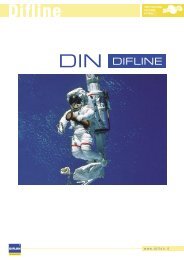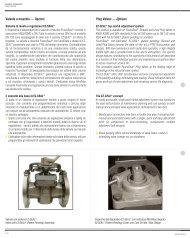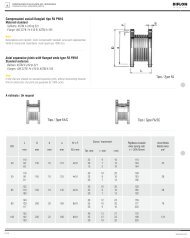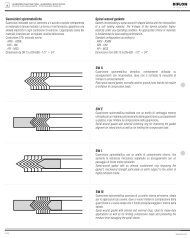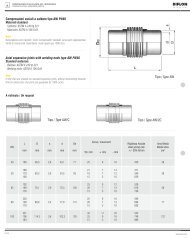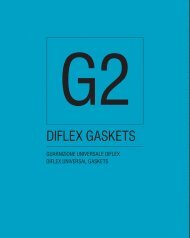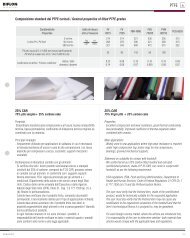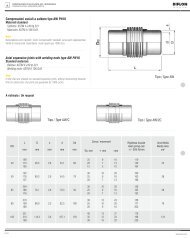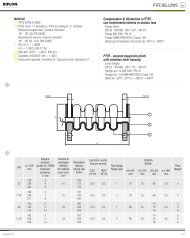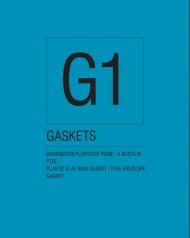Difline - Diflon - PTFE
Difline - Diflon - PTFE
Difline - Diflon - PTFE
- No tags were found...
You also want an ePaper? Increase the reach of your titles
YUMPU automatically turns print PDFs into web optimized ePapers that Google loves.
<strong>Difline</strong>DIFLINETUBI E RACCORDIPIPES ANDFITTINGSIntroduzioneIl Politetrafluoroetilene (<strong>PTFE</strong>) è una materia plastica ottenuta per polimerizzazionedel tetrafluoroetilene (CF4), ottenuto a sua volta dallapirolisi del difluoroclorometano (CH C1 F2). L’invenzione del <strong>PTFE</strong> èdatata 1938 ed è dovuta all’americano Plunkett, l’inizio della suadiffusione avviene negli anni ‘50, mentre la produzione su largascala parte dagli anni ‘60. L’insieme delle elevate caratteristiche checontraddistingue il <strong>PTFE</strong>, ne ha decretato il successo rendendolo unprodotto unico; da esso sono stati pure sviluppati derivati quali il PFA,FEP, PVDF, il PTFCE, ecc. ognuno dei quali presenta caratteristicheparticolari che li rende idonei a specifici impieghi. Il <strong>PTFE</strong>, però,rimane l’unico a sommare tutte le caratteristiche più esaltanti, trale quali citiamo:- totale antiaderenza- inattaccabilità dalla quasi totalità delle sostanze chimiche- temperatura di utilizzo da -200°C a +270°C circa per impiegocontinuo- notevoli caratteristiche meccaniche- perfetta lavorabilità all’utensile- atossicità- basso coefficiente di attrito- ininfiammabilità- nessun assorbimento d’acqua.Questo catalogo e le tabelle annesse, vogliono essere una guidaper coloro che intendono trovare, nei prodotti <strong>Diflon</strong>, la soluzione aproblemi altrimenti irrisolvibili, e che intendono utilizzare materialiincontaminati per la salvaguardia della qualità dei loro prodotti e ledoti di versatilità ed antinvecchiamento del <strong>PTFE</strong> effettuando nonsolo un acquisto ma anche un investimento nel prodotto e nellasicurezza.NoteLe tabelle dimensionali e i materiali possono subire variazioni neltempo, quindi il catalogo ha carattere di indicazione generale e nonpuò costituire una garanzia.Caratteristiche dei prodotti <strong>Difline</strong>Le particolarità dei prodotti <strong>Difline</strong> sono qui sotto elencate:1. Finitura e lavorazione all’utensile dei manufatti prima di assemblarliper rendere gli accoppiamenti perfettamente paralleli e gli spessoridel <strong>PTFE</strong> costanti in ogni loro parte.2. La cartellatura è eseguita con tecniche nuove e all’avanguardia nelcampo della lavorazione del <strong>PTFE</strong>; da qui ne deriva la completaadesione del <strong>PTFE</strong> alla cartella di ferro. Quindi il <strong>PTFE</strong>, anche adistanza di anni non subirà deformazioni di alcun genere.3. Le flange, una libera e una fissa, fanno apprezzare le tubazioni edi raccordi <strong>Diflon</strong> per la loro comodità di installazione.4. Vengono applicati, di serie dalla <strong>Diflon</strong>, spessori di <strong>PTFE</strong> da unmin. di 3 mm ad un max. di 7 mm; spessori che, oltre a consentirel’esercizio sotto vuoto, sono tra i più alti sul mercato delle tubazionirivestite in <strong>PTFE</strong>.5. La <strong>Diflon</strong> mette a disposizione una vasta gamma di prodotti, nonlimitata alle sole tubazioni rettilinee e raccordi rivestiti internamentein <strong>PTFE</strong>, ma comprensiva di tutto ciò che interessa l’impiantistica(guarnizioni, soffietti, tubi flessibili, rivestimento di attacchi rapidi,IntroductionPolytetrafluoroethylene (<strong>PTFE</strong>) is produced by polymerization of tetrafluoro-ethylene(CF4), which is obtained by pyrolysis of difluorochloromethane(CH C1 F2).<strong>PTFE</strong> invention dates back to 1938, when this compound was developedby Mr. Plunkett. This product’s widespread use started in thefifties, where as its mass-production started in the sixties.The success of this product is due to its particular, qualified characteristics,making <strong>PTFE</strong> something unique. Many derivatives havebeen developed by this product, such as PFA, FEP, PVDF, PTFCE,etc. each featuring distinctive properties that make them suitable forspecific uses. <strong>PTFE</strong> only maintains the highest properties such as:- totally non-sticking- chemical inertness towards nearly all known chemicals- service temperature range approximately -200°C up to +270°Cunder continuous working conditions.- remarkable mechanical properties- perfect machinability- non toxicity- low friction coefficient- flame retardancy- no water absorption.This catalogue and the annexed tables provide a guide to seek in<strong>Diflon</strong> products the solution of unsolvable problems, as well as tomake of non contaminant materials for safeguarding the quality ofproducts.NotesThe tables of dimensions and materials can be subject to variationsin time, therefore only have the character of general indications.This catalogue does not, under any circumstances, act as aguarantee.Characteristics of <strong>Difline</strong> productsHere is some particular information about <strong>Difline</strong> products:1. Machine-tool finish and machining of items before their assembly,in order that couplings are perfectly parallel and <strong>PTFE</strong> thicknessconstant in every part.2. The adhesion of <strong>PTFE</strong> to the stub ends is carried out with new,state-of-the-art <strong>PTFE</strong> machining techniques; therefore <strong>PTFE</strong> perfectlyadheres to the stub ends. This way, <strong>PTFE</strong>, even after yearsof service life, is not subject to any strain whatsoever.3. Flanges, one free and one fixed, contribute to the easy installationof all <strong>Diflon</strong> pipes and fittings.4. <strong>Diflon</strong> applies <strong>PTFE</strong> in standard thicknesses ranging from a minimumof 3 mm to a maximum of 7 mm, these thicknesses, besidesallowing vacuum service, rank amongst the highest on the marketof <strong>PTFE</strong>-lined piping.5. <strong>Diflon</strong> offers a broad range of products, which is not confined to<strong>PTFE</strong>-lined straight pipes and fittings, but also includes everythinginvolved in installation (gaskets, bellows, hose, linings of snap-onconnections, sensors, tanks, columns, etc.).6. <strong>Diflon</strong> is highly considered by Maintenance Contractors thanks tothe short delivery times and the large choice of products right offthe shelf.®DIFLONTECHNOLOGY9w w w . d i f l o n . i t®
<strong>Difline</strong>DIFLINETUBI E RACCORDIPIPES ANDFITTINGSResistenza al vuoto dei tubi e raccordi in acciaio al carbonio riv. <strong>PTFE</strong>Vacuum resistance of carbon steel <strong>PTFE</strong> lined pipes and fittingsDNTemperatura ° CTemperature ° CSpessore/Thk. <strong>PTFE</strong>: STD=Standard HD=Maggiorato/Heavy duty23°C 100°C 150°C 200°CPollici/Inch STD HD STD HD STD HD STD HD15 1/2” 0 0 0 0 0 0 0 020 3/4” 0 0 0 0 0 0 0 025 1” 0 0 0 0 0 0 0 032 1”1/4 0 0 0 0 0 0 0 040 1”1/2 0 0 0 0 0 0 0 050 2” 0 0 0 0 0 0 0 065 2”1/2 0 0 0 0 0 0 0 080 3” 0 0 0 0 0 0 0 0100 4” 10 4 0 1,5 x 10 4 0 3 x 10 4 0 3,5 x 10 4 0125 5” 1,5 x 10 4 0 2,5 x 10 4 0 3,5 x 10 4 0 4,5 x 10 4 0150 6” 1,5 x 10 4 0 2,5 x 10 4 0 3,5 x 10 4 0 4,5 x 10 4 0200 8” 2 x 10 4 0 8 x 10 4 0 9,5 x 10 4 0 10 5 0250 10” 5 x 10 4 0 9,5 x 10 4 0 10 5 0 10 5 0300 12” 8 x 10 4 0 9,5 x 10 4 0 10 5 0 10 5 0Altre dimensioni su richiesta/Other dimensions on requestTabella 1/Table 1<strong>PTFE</strong>Il <strong>PTFE</strong> utilizzato normalmente dalla DIflon per il rivestimento delletubazioni e dei raccordi è fornito dalle maggiori industrie di produzionedella materia prima.Le caratteristiche del <strong>PTFE</strong> sono indicate in tabella 4. I rivestimentiinterni di tubazioni rettilinee vengono ottenuti per RAM-EXTRUSIONsecondo D 4894 e successiva stabilizzazione, oppure <strong>PTFE</strong> da pastaASTM D 4895. I rivestimenti interni per la raccorderia, e i componentisagomati vengono ottenuti mediante stampaggio isostatico e sinterizzazione,secondo D 4894. I componenti per impiantistica distribuitidalla <strong>Diflon</strong> hanno un rilevante spessore, come indicato nelle tabelle,essi consentono di garantire, oltre alle prestazioni già note del <strong>PTFE</strong>,anche una rilevante o totale resistenza al vuoto (vedi tabella 1).FlangiatureLa produzione <strong>Diflon</strong> per impiantistica viene normalmente approntatacon flangiatura UNI PN 10/16 o ANSI 150/300; a richiesta vengonoeseguite forniture con flangiature diverse, sia come pressioni di progetto,sia come normative.<strong>PTFE</strong><strong>PTFE</strong> raw materials employed for <strong>Diflon</strong> pipe linings are supplied bymajor producers. The <strong>PTFE</strong> characteristics are shown in table 4.The linings of straight pipes are obtained with the RAM-EXTRUSIONprocess according to D 4894 with subsequent stabilization, or from<strong>PTFE</strong> paste according to ASTM D 4895. Linings intended for fittingsas well as shaped items are manufactured by isostatic molding andsintering, according to D 4894. The engineering components distributedby <strong>Diflon</strong> have a considerable thickness, as shown in table n.1; they also ensure considerable resistance against vacuum.Flanging<strong>Diflon</strong>’s items are manufactured with standard flanging complyingwith UNI PN 10/16 or ANSI 150/300 standards; upon request, specialflangings can be manufactured according to the given pressureparameters and standards.®DIFLONTECHNOLOGY11w w w . d i f l o n . i t®
TUBI E RACCORDIPIPES ANDFITTINGSDIFLINE<strong>Difline</strong>Pezzi specialiOltre alla produzione standard indicata nel presente catalogo, possonoessere approntati pezzi speciali, rivestimenti di componentiper apparecchiature, sulla base di specifiche, disegni, o indicazionifornite dal cliente stesso.Componenti in <strong>PTFE</strong>Una delle caratteristiche particolari del <strong>PTFE</strong> è, oltre alla stampaggioisostatico (secondo opportune tecniche), la perfetta lavorabilitàall’utensile. Ciò rende possibile la costruzione di pezzi particolarmenteformati o complessi, adatti agli utilizzi più svariati. Citiamo,ad esempio, le parti meccaniche quali boccole, soffietti, O-Rings,anelli per tenuta, isolatori; mentre per l’impiantistica possiamo citarecomponenti quali i pescanti, sparger, distanziali per flangiature, sfereper valvole di ritegno e galleggianti, guaine termometriche pezzi adisegno. In virtù della lavorabilità del <strong>PTFE</strong>, non vi sono praticamentelimiti alla possibilità di approntare, su richiesta, qualsiasi componentespeciale per l’impiantistica.Controllo di qualità dei manufatti e certificatiFanno parte dei controlli (non distruttivi) effettuati sui prodotti perimpiantistica DIFLON:- proprietà fisiche del <strong>PTFE</strong>- proprietà fisiche e chimiche dell’acciaio utilizzato- controllo dimensionale dei manufatti- controllo delle tolleranze di lavorazione- simulazione dei limiti di impiego previsti- controllo con scintillometro a 15000 V sul 100% delle parti in <strong>PTFE</strong>lavorate.Normalmente i controlli sopracitati sono effettuati a “spot”; su specificarichiesta essi possono essere estesi a tutti i componenti facentiparte di una fornitura. Infine, sempre su incarico, possono essereeffettuate prove distruttive per la determinazione di condizioni limitedi impiego dei componenti.Vengono forniti a richiesta certificati delle prove eseguite e dei materialiimpiegati secondo EN 10204 - 3.1.B/2 - 1Preparazione finale delle superficie verniciaturaLe superfici in acciaio vengono normalmente trattate con spazzolaturaed una mano di antiruggine a base epossidica. Su richiestapossono anche essere effettuate le seguenti operazioni aggiuntive:• sabbiatura, grado SA 21⁄2• applicazione di una o due mani di smalto epossidico, nel colorerichiesto• applicazioni di vernici zincanti.Special itemsSpecial items such as linings of components for equipment, based onspecifications, drawings, or requirements submitted by the customer,can be manufactured.<strong>PTFE</strong> componentsThanks to <strong>PTFE</strong> high machinability and isostatic moldability (accordingto specific techniques), specially shaped or complex items, suitablefor the most varied used, can be easily obtained, therefore no limitexists to the production of any special component. We mention heremechanical parts, such as bushings, bellows, O-rings, sealing rings,isolators, as well as engineering components such as dip-pipes,spargers, flange spacers, balls for check valves and/or float valves,thermowells, parts on customer’s specifications.Quality controlNon-destructive tests carried out on <strong>Diflon</strong> engineering productsinclude:- physical properties of <strong>PTFE</strong>- physical and chemical properties of steel- dimensional check of items- check of machining tolerances- simulation of the expected application limits.The above tests and checks are usually performed “on the spot”;upon specific request, they can be extended to all componentsmaking part of a supply. Finally, on request, destructive tests can becarried out for the determination of the application limit conditions ofthe items.Final treatment of surfaces and paintingSteel surfaces are normally finished by brushing, and by applying anepoxy-based rust proofing paint:• sandblasting to SA2 1/2 grade• application of one or two coats of an epoxy enamel in the requiredcolor• application of zinc-rich paints can be additionally carried out.w w w . d i f l o n . i t12®DIFLONTECHNOLOGY
<strong>Difline</strong>DIFLINETUBI E RACCORDIPIPES ANDFITTINGSTabelle forza di serraggio raccomandata/Tables of recommended tightening torque valuesPN 10 PN 16DNn° bulloni x filettaturano. of bolts x threadForza serraggioBolt torqueN/mn° bulloni x filettaturano. of bolts x threadForza serraggioBolt torqueN/m15 4 x M12 27 4 x M12 2720 4 x M12 27 4 x M12 2725 4 x M12 27 4 x M12 2732 4 x M16 30 4 x M16 3040 4 x M16 30 4 x M16 3050 4 x M16 45 4 x M16 4565 4 x M16 55 8 x M16 5580 8 x M16 55 8 x M16 55100 8 x M16 58 8 x M20 58125 8 x M16 80 8 x M24 85150 8 x M20 85 8 x M24 85200 8 x M20 120 12 x M24 80250 12 x M20 100 12 x M27 115300 12 x M20 120 16 x M27 150350 16 x M20 140 16 x M30 155400 16 x M24 150 16 x M33 190500 20 x M24 155 20 x M33 205600 20 x M27 185 20 x M36 235Tabella 2/Table 2S. 150 S. 300DNn° bulloni x filettaturano. of bolts x threadForza serraggioBolt torqueN/mn° bulloni x filettaturano. of bolts x threadForza serraggioBolt torqueN/m1/2” 4 x 1/2” 15 4 x 1/2” 203/4” 4 x 1/2” 15 4 x 5/8” 201” 4 x 1/2” 15 4 x 5/8” 201”1/2 4 x 1/2” 21 4 x 3/4” 252” 4 x 1/2” 37 8 x 5/8” 302”1/2 4 x 5/8” 45 8 x 3/4” 403” 4 x 5/8” 60 8 x 3/4” 474” 8 x 5/8” 45 8 x 3/4” 685” 8 x 3/4” 60 8 x 3/4” 1006” 8 x 3/4” 85 12 x 3/4” 1058” 8 x 3/4” 105 12 x 7/8” 11010” 12 x 7/8” 105 16 x 1” 12012” 12 x 7/8” 130 - -14” 12 x 1” 200 - -16” 16 x 1” 195 - -18” 16 x 1”1/8 280 - -20” 20 x 1”1/8 250 - -24” 20 x 1”1/4 300 - -Tabella 3/Table 3®DIFLONw w w . d i f l o n . i t®TECHNOLOGY13
TUBI E RACCORDIPIPES ANDFITTINGSDIFLINE<strong>Difline</strong>Protezione per trasporto e stoccaggioTutti i componenti per impiantistica costruiti da <strong>Diflon</strong> sono forniticompleti di protezioni, in plastica o in precompresso, sulle cartelle incorrispondenza delle flangiature, per proteggerle durante il trasportoe per tutto il periodo di stoccaggio, in attesa di utilizzo.Le protezioni devono essere rimosse solo immediatamente prima delmontaggio e dell’assiemaggio con gli altri componenti. L’eventualedanneggiamento, per urto, della superficie di tenuta sulla flangia puòcompromettere l’utilizzo dell’intero pezzo.Marcatura dei pezziLe forniture <strong>Diflon</strong> comprendono la marcatura di tutti i pezzi, in basealla codifica desiderata, oppure, nel caso di sketches, in base allaloro numerazione e posizione. In questo ultimo caso si evita di creareconfusione tra i componenti dei vari sketches.Istruzioni per assiemaggio e montaggiodi apparecchiature, tubazioni e raccorderiain acciaio rivestito in <strong>PTFE</strong> - <strong>Difline</strong>Il montaggio delle tubazioni rivestite in <strong>PTFE</strong> prodotte da <strong>Diflon</strong> nonrichiede particolari attrezzature; devono comunque essere rispettatealcune regole fondamentali, necessarie per consentire un utilizzoottimale di tutti i componenti.• Effettuare un rilievo accurato in loco delle misure relative alle tubazionida costruire; si eviteranno adattamenti e soluzioni di ripiego,non idonei al servizio a cui le tubazioni sono destinate.• Utilizzare dove possibile, pezzi standard; ne risulterà facilitata ad uneventuale sostituzione.• Prevedere, dove possibile, supporti e staffaggi regolabili; si eviterannoinutili tensioni alle tubazioni sia durante il montaggio siadurante l’esercizio, dovute all’imprecisione o al non perfetto allineamentodegli staffaggi.• Non cercare di adattare le tubazioni forzandole; si otterrà solamenteuna tenuta precaria degli accoppiamenti flangiati. Per eventualiadattamenti utilizzare gli spessori in <strong>PTFE</strong> massiccio.• Non effettuare saldature sui componenti in acciaio rivestiti in <strong>PTFE</strong>,seguendo il metodo tradizionale; il rivestimento ne verrebbe irrimediabilmentecompromesso.• Non inserire alcun tipo di mastice, sigillante o adesivo, tra leflangiature; ne risulterebbe compromessa la tenuta e l’integrità deicomponenti.• È consigliabile, per gli accoppiamenti flangiati, l’utilizzo di unachiave dinamometrica; si otterrà una pressione di serraggio uniformementedistribuita su tutta la superficie di tenuta.• Consigliamo di adottare guarnizioni in Diflex sugli accoppiamentiper salvaguardare le cartelle da eventuali serraggi non corretti.Omologazioni - certificazioni• Il prodotto <strong>Difline</strong> è omologato secondo ASTM F423, compreseprove alla permeabilità (Bollettino Tecnico N° 2).• Certificazione CE/PED secondo direttiva 97/23/CE (PED).Protection for handling and storageAll <strong>Diflon</strong> items are provided by suitable protections, such as plasticor special cardboard caps on the stub ends at the flanges, to protectthem from damage during transportation, handling and throughoutthe storage period, until they are used. Protections shall be removedonly immediately before installation and assembly with the othercomponents. The accidental damage, due to impact, of the sealingface of the flange can seriously impair the entire item.Marking of the items<strong>Diflon</strong> supplies include the marking of all items, according to therequired codes, or in case of sketches, to their numbering; it avoidsmixing up of the components of various sketches.Assembly and set up of equipment,steel pipes and fittings <strong>PTFE</strong> lined steelNo particular tool is required to assemble <strong>PTFE</strong>-lined pipesmanufactured by <strong>Diflon</strong>; nevertheless, some basic rules should becomplied with for the optimum performance of all components.• A thorough on-site survey should be carried out to determine thesize and dimensions of the piping to be installed; this is in orderto avoid post-installation adjustments and makeshift solutionsunsuitable for the intended service.• Whenever possible, standard items should be used in order tofacilitate eventual replacement.• Adjustable sleepers and supports should be foreseen to avoidany strain in pipes due to inaccuracy and imperfect alignment ofsupports during assembly and operation.• Pipes should not be forced when adjusting them, an unstablesealing of the flanged couplings only could be achieved.• Should any adjustment be required, shimming rings or solid <strong>PTFE</strong>shimming units must be employed.• In order to avoid permanent damage, <strong>PTFE</strong>-lined steel componentsshould not be welded according to the conventional procedure.• No sealing compound or adhesive putty should be inserted betweenthe flanges; it could impair their tightness and integrity.• The use of a torque wrench is recommended for flanged couplings;a tightening pressure will be achieved that is evenly distributedthroughout the sealing surface.• The use of Diflex gaskets is recommended on couplings in order toprotect stub ends from incorrect tightening.Homologations - Certificates• <strong>Difline</strong> products are homologated in compliance with ASTM F423standards, including the permeability tests(Technical Bulletin no. 2).• CE/PED certificate according to the 97/23/EC directive (PED).w w w . d i f l o n . i t14®DIFLONTECHNOLOGY
<strong>Difline</strong>DIFLINETUBI E RACCORDIPIPES ANDFITTINGSCaratteristiche del <strong>PTFE</strong>1. Il politetrafluoroetilene (<strong>PTFE</strong>), commercialmente noto con i nomi diTEFLON, ALGOFLON, FLUON ecc., è un polimero del tetrafluoroetileneche possiede un insieme di caratteristiche fisico chimiche non riscontratein nessun altro materiale plastico.Tra tali caratteristiche le principali sono:- estrema inerzia chimica- eccellente resistenza al calore- ottime caratteristiche dielettriche- ottima resistenza all’invecchiamento- caratteristiche autolubrificanti e minimo coefficiente di attrito- impermeabilità.2. Proprietà chimicheIl <strong>PTFE</strong> è inerte nei confronti di praticamente tutti i reagenti chimicinoti; esso viene attaccato solo dai metalli alcalini allo stato elementaread alta temperatura e pressione. Il <strong>PTFE</strong> è insolubile in qualsiasisolvente a temperatura fino a 300°C. Solo a temperature prossimeal punto di fusione cristallino alcuni olii altamente fluorurati possonorigonfiarlo e scioglierlo.3. Proprietà termicheIl <strong>PTFE</strong> ha un basso coefficiente di trasmissione termica ed è perciòconsiderato un isolante termico. Non è infiammabile ed è stabile pertempi indeterminatamente lunghi fino a 260°C.4. Proprietà elettricheIl <strong>PTFE</strong> possiede ottime qualità dielettriche in un ampio campo ditemperature e frequenze. Essendo l’assorbimento d’acqua praticamentenullo, le caratteristiche si mantengono invariate anche dopoprolungate esposizioni agli agenti atmosferici. La rigidità dielettricanon è praticamente influenzata dalla temperatura di esercizio.La resistenza all’arco è notevole e l’azione dell’arco non provocadepositi carboniosi ma soltanto vapori non conduttori. Anche lealtre proprietà elettriche (costante dielettrica, resistività superficiale,resistività di volume, fattore di potenza ecc.) sono particolarmenteinteressanti.5. Proprietà meccanicheLe proprietà meccaniche del <strong>PTFE</strong> riferite alla temperatura di 23°Csono indicate nella tabella seguente. E’ importante osservare che alletemperature comprese tra i 19°C ed i 21°C, il materiale presentaun punto di transizione, determinato da una modifica nella strutturacristallina, che provoca una variazione di volume di circa l’1%. Altrecaratteristiche peculiari del <strong>PTFE</strong> sono l’antiadesività ed il bassocoefficiente di atrito, in particolare con carichi abbastanza elevati.6. Caratteristiche generali del <strong>PTFE</strong> stampatoLe caratteristiche generali del <strong>PTFE</strong> stampato sono espresse nellaseguente tabella.<strong>PTFE</strong> properties1. Polytetrafluorethylene (<strong>PTFE</strong>) commercially known under the trademarksTEFLON, ALGOFLON, FLUON, etc. is a tetrafluoro-ethylenepolymer, featuring a number of chemical-physical properties whichare not encountered in any other plastics.The main characteristics are the following:- extreme chemical inertness- excellent heat resistance- optimum dielectric properties- optimum aging resistance- self-lubricating properties and low friction coefficient- water repellency.2. Chemical properties<strong>PTFE</strong> is inert to almost all known chemical reagents; it is onlyattached by elementary alkaline metals, under high temperatureand pressure conditions. At temperatures up to 300°C, <strong>PTFE</strong> is ininsoluble in any solvent. Only at temperatures around the crystallinemelting point some highly fluorinated oils can swell and solve it.3. Thermal properties<strong>PTFE</strong> has a low heat transfer coefficient, and is therefore regardedas an insulating material. It is flame retardant, and indefinitely stableup to 260°C.4. Electrical properties<strong>PTFE</strong> has very good dielectric properties within a broad range oftemperatures and frequencies. Since this product does not absorbany moisture, its properties remain unaltered even after prolongedexposure to weather agents.The dielectric strength is unaffected by the operating temperature.The arc resistance is remarkable, and the action of the arc does notresult in carbon deposits but only nonconductive vapors.Particularly interesting are also the other electrical properties (suchas the dielectric constant, the surface resistivity, volume resistivity,power factor, etc.).5. Mechanical properties<strong>PTFE</strong> mechanical properties, at a temperature of 23°C, are shownin the following table. At temperatures ranging from 19°C to 21°C,this material features a transition point, determined by change in thecrystalline structure, provoking a variation in volume of approximately1%. Other particular <strong>PTFE</strong> characteristics include non-adhesivenessand low friction coefficient, mainly under rather high loads.6. General properties of molded <strong>PTFE</strong>The following table shows the general characteristics of molded<strong>PTFE</strong>.®DIFLONTECHNOLOGY15w w w . d i f l o n . i t®
TUBI E RACCORDIPIPES ANDFITTINGSDIFLINE<strong>Difline</strong>Specifica materiale - caratteristiche tipiche/Material typical propertiesTabella 4/Table 4CaratteristichePropertiesMetodoMethodUnità di misuraUnit of measureValoriValuesPeso specifico/Specific gravity ISO 1183 - 2,130 - 2,180Carico di rottura a trazione/Tensile strength ISO 527 MPa 20 - 30Allungamento/Elongation ISO 527 % 200 - 350Durezza/Hardness ISO 868 Shore D 54 - 60Modulo di elasticità/Flexural modulus 23°C N/mm 2 600 - 700Deformazione sotto carico (140 kg/cm 2 per 24 hr a 23°C) ASTM D695 % 10 - 13Deformation under load (140 kg/cm 2 for 24 hrs at 23°C)Deformazione permanente (dopo 24 hr - Rilassamento a 23°C) ASTM D695 % 6 - 7,5Permanent deformation (after 24 hrs - Relaxation at 23°C)Coefficiente di atrito/Friction coefficient ASTM D1894 / Dynamic 0,07Costante dielettrica a 60 Hz da 2GHz ASTM D150 / 2,1Dielectric constant at 60 Hz to 2GHzRigidità dielettrica/Dielectric strength ASTM D149 kV/mm 20 -70Resistività volumetrica/Volume resistivity ASTM D275 Ohm cm 10 18Infiammabilità/Flammability UL 94 % VE-0Punto di fusione/Melting point °C 325 - 335Assorbimento all’acqua/Water absorption ASTM D570 % 0,01Esempi di produzione: inox rivestito in <strong>PTFE</strong>Some <strong>PTFE</strong>-lined stainless steel components<strong>PTFE</strong> stampato isostatico/Isostatic <strong>PTFE</strong> moldingEsempi di produzione <strong>Difline</strong>/Some <strong>Difline</strong>-lined partsEsempi di produzione <strong>Difline</strong>/Some <strong>Difline</strong>-lined partsw w w . d i f l o n . i t16®DIFLONTECHNOLOGY



